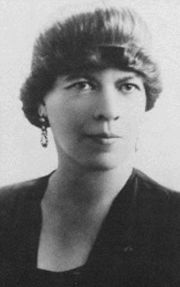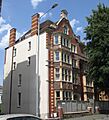Ivy Compton-Burnett facts for kids
Quick facts for kids
Ivy Compton-Burnett
|
|
|---|---|
 |
|
| Born | 5 June 1884 |
| Died | 27 August 1969 (aged 85) Kensington, London, England
|
| Occupation | Novelist |
Dame Ivy Compton-Burnett (born June 5, 1884 – died August 27, 1969) was an English novelist. She wrote many books, often published as I. Compton-Burnett. In 1955, she won the James Tait Black Memorial Prize for her novel Mother and Son. Her stories are mostly told through conversations between characters. They focus on family life among the upper middle class in late Victorian or Edwardian times.
Early Life and Family
Ivy Compton-Burnett was born in Pinner, Middlesex, England, on June 5, 1884. She was the seventh of twelve children. Her father, Dr. James Compton-Burnett, was a doctor and writer. Her mother was Katharine Rees.
Many people thought Ivy's family came from rich landowners. However, her family actually came from small farmers. Her great-grandfather and grandfather were farm labourers. Ivy's family moved four times before she was 14. They lived in new suburban areas.
Ivy grew up in Hove and London. She was taught at home with her two brothers until she was 14. Later, she went to Addiscombe College in Hove. She also studied Classics at Royal Holloway College, University of London. After college, she taught her four younger sisters at home.
Ivy's mother sent her stepchildren to boarding school. After her father died, Ivy's mother became very demanding. This gave Ivy ideas for characters in her books. Four of Ivy's sisters left home in 1915. They moved to London to live with a friend. Ivy managed the family's money after her mother passed away.
Ivy Compton-Burnett once wrote about her life: "I have had such an uneventful life that there is little information to give. I was educated with my brothers in the country as a child, and later went to Holloway College, and took a degree in Classics. I lived with my family when I was quite young but for most of my life have had my own flat in London. I see a good deal of a good many friends, not all of them writing people. And there is really no more to say."
Close Friend
Ivy Compton-Burnett spent much of her life with Margaret Jourdain (1876–1951). Margaret was an expert on furniture and decorative arts. They shared a flat in Kensington from 1919. For the first ten years, Ivy was very quiet. Margaret did not even know her friend was writing a novel until Pastors and Masters came out in 1925.
Awards
Ivy Compton-Burnett was given a special honour in 1967. She was made a Dame Commander of the Order of the British Empire (DBE).
Death
Ivy Compton-Burnett died at her home in Kensington on August 27, 1969. She was 85 years old. She was cremated at Putney Vale Crematorium.
Her Books
Most of Ivy Compton-Burnett's books are about families. They show the weaknesses of people. The families in her novels often have problems. Parents might struggle with their children. Brothers and sisters might have hidden power struggles.
Her writing style was very unique. She started this style with her book Pastors and Masters in 1925. Her stories use a lot of formal dialogue. This means characters talk in a very proper way. Readers need to pay close attention. Sometimes, important information is mentioned very quickly. Her writing creates a focused world. It explores how people use power in small family settings.
Images for kids
See also
 In Spanish: Ivy Compton-Burnett para niños
In Spanish: Ivy Compton-Burnett para niños


